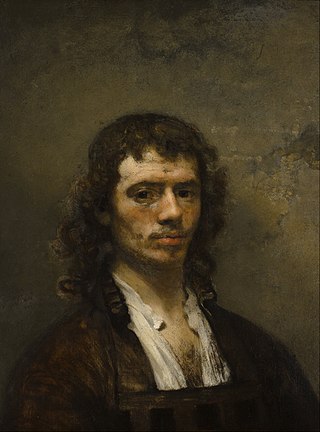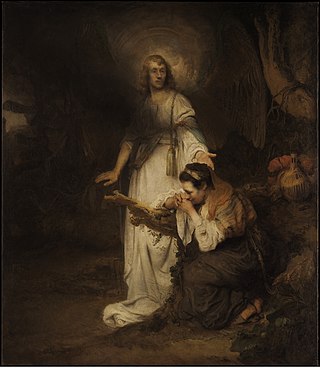
Carel Pietersz. Fabritius was a Dutch painter. He was a pupil of Rembrandt and worked in his studio in Amsterdam. Fabritius, who was a member of the Delft School, developed his own artistic style and experimented with perspective and lighting. Among his works are A View of Delft, The Goldfinch (1654), and The Sentry (1654).

The White Palace is the official residence of the Yugoslav former royal family. It is located within the Royal Compound, in the Dedinje neighborhood of Belgrade.
Sentry or The Sentry may refer to:

Cornelis Corneliszoon van Haarlem was a Dutch Golden Age painter and draughtsman, one of the leading Northern Mannerist artists in the Netherlands, and an important forerunner of Frans Hals as a portraitist.

The Staatliches Museum Schwerin is an art gallery and museum in Schwerin in Germany. It was established by Frederick Francis II, Grand Duke of Mecklenburg-Schwerin in 1882 its historicist Haupthaus as the Staatsgalerie next to the Staatstheater. Its other locations are opposite the Schweriner Schloss and in the former residences at Schloss Güstrow and Schloss Ludwigslust.

Portrait of a Seated Woman with a Handkerchief is a painting at the Art Gallery of Ontario, in Toronto. Today it is attributed to Carel Fabritius, but was previously considered a work by Rembrandt.

Carel van Savoyen or Carel van Savoy (1620/21–1665) was a Flemish painter, draughtsman and printmaker who was active in Antwerp and Amsterdam. He is mainly known for his history paintings and portraits but he also painted allegories and genre scenes.

The Polish Rider is a seventeenth-century painting, usually dated to the 1650s, of a young man traveling on horseback through a murky landscape, now in The Frick Collection in New York. When the painting was sold by Zdzisław Tarnowski to Henry Frick in 1910, there was consensus that the work was by the Dutch painter Rembrandt. This attribution has since been contested, though those who contest it remain in the minority.

Cornelis Hofstede de Groot, was a Dutch art collector, art historian and museum curator.

The Goldfinch is a novel by the American author Donna Tartt. It won the 2014 Pulitzer Prize for Fiction, among other honors. Published in 2013, it was Tartt's first novel since The Little Friend in 2002.

Museum Fodor is a former art museum in Amsterdam in the Netherlands. The museum was located at the Keizersgracht in Amsterdam-Centrum in the building that currently houses the Foam Fotografiemuseum Amsterdam.

Slaughtered Ox, also known as Flayed Ox, Side of Beef, or Carcass of Beef, is a 1655 oil on beech panel still life painting by Rembrandt. It has been in the collection of the Louvre in Paris since 1857. A similar painting is in Kelvingrove Art Gallery and Museum, Glasgow, possibly not created by Rembrandt himself but probably by one of his pupils, perhaps Carel Fabritius. Other similar paintings by Rembrandt or more likely his circle are held by museums in Budapest and Philadelphia.

The Goldfinch is a painting by the Dutch Golden Age artist Carel Fabritius of a life-sized chained goldfinch. Signed and dated 1654, it is now in the collection of the Mauritshuis in The Hague, Netherlands. The work is a trompe-l'œil oil on panel measuring 33.5 by 22.8 centimetres that was once part of a larger structure, perhaps a window jamb or a protective cover. It is possible that the painting was in its creator's workshop in Delft at the time of the gunpowder explosion that killed him and destroyed much of the city.

A View of Delft, with a Musical Instrument Seller's Stall is a 1652 painting by Carel Fabritius. It is an oil painting on canvas of 20.9 by 35.7 cm of a cityscape of Delft. The work has been in the collection of the National Gallery in London since 1922. The unusual perspective distortion, especially visible to the right of the church, suggests that it may have been intended to have been displayed on a curved surface at the back of a perspective box hence making an illusion of anamorphosis. Fabritius is mentioned in contemporary documents in connection with perspective boxes. The view is of the Nieuwe Kerk facing the Town Hall and several houses, one of which is still extant, at the point where the Oude Langendijk canal meets the Vrouwenrecht. The size of the canvas, exceptionally small for a cityscape of its kind, also supports the perspective-box hypothesis. Another possibility is that Fabritius designed the picture with the aid of a double-convex lens, as these may create distorted proportions in a pattern akin to those seen in the painting. However, material analyses carried out during conservation strengthen the possibility of the perspective-box view.

A Young Man in a Fur Cap and a Cuirass (probably a Self Portrait) is a 1654 portrait painting by Carel Fabritius. It is an oil painting on canvas of 70.5 by 61.5 cm (27.8 by 24.2 in). The painting is generally considered to be a self-portrait. The work has been in the collection of the National Gallery in London since 1924.

Portrait of Abraham de Potter, Amsterdam Silk Merchant is a 1649 portrait painting of silk merchant Abraham de Potter by Carel Fabritius. The oil painting on canvas is 68.5 by 57 cm. The work has been in the collection of the Rijksmuseum in Amsterdam since 1892.

A Sparrowhawk is a painting by Venetian artist Jacopo de' Barbari, probably made late in the 1510s, while he was working in the Netherlands towards the end of his life.

Hagar and the Angel is an oil-on-canvas painting of a scene from the Book of Genesis by Carel Fabritius, created c.1643–1645 during that artist's time in Rembrandt's studio or shortly afterwards. It is now in the Leiden Collection in New York.

Hera or Hera Hiding During the Battle Between the Gods and the Giants is a c.1643 oil on canvas painting by Carel Fabritius, produced during his apprenticeship in Rembrandt's studio or shortly afterwards. It is now in the Pushkin Museum in Moscow.


















